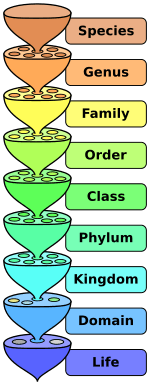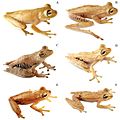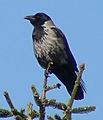Species facts for kids
A species is a kind of organism. It is a basic unit of biological classification, and a formal rank in taxonomy. Originally, the word was used informally in a rather vague way, but now there are at least 26 different ways it is used.
All animals or plants that are the same kind belong to the same species. Wolves (Canis lupus) are one species. Humans are another species. Broadly, the idea is that (say) cats breed with cats and produce more cats. This is the basis for deciding to have a species named Felis catus. However, giving a simple definition of 'species' is rather difficult, and many people have tried.
Species is a word for a special kind of living thing, like a crow. Crows and ravens are similar but not the same, so they are together in a bigger group (taxon) called a genus. Then there is a family (like the crow family, which includes crows and ravens as well as jays and magpies), and then an order such as the songbirds, (which has many families in it, such as the crow, thrush and swallow families). The next group is the class; all birds are in the same class. After that is the phylum, such as vertebrates, which is all animals with backbones. Last of all is the kingdom, like the animal kingdom. These are ways to classify living things.
There is a mnemonic to help people remember the order of the divisions which are listed again below: "King Phillip Came Over For Great Spaghetti".
Example
Take as an example the bird called a Common Loon or Great Northern Diver:
- Kingdom: Animalia
- Phylum: Chordata
- Class: Aves
- Order: Gaviiformes
- Family: Gaviidae
- Genus: Gavia
- Species: Gavia immer
- Common name: Common Loon or Great Northern Diver.
Historical changes in the term
There is a long history of disagreement over whether species are objective things, or whether they are man-made labels. Those who think species are objectively different point to things which 'good' species do. They look similar, and they breed true, that is, mate with their own kind, and have offspring which are obviously in the same species.
Against this are the many exceptions. There are species which shade gradually into other species, and which interbreed in overlapping populations (see ring species). On the other hand, there are species which look absolutely identical, but which do not breed together (sibling species).
It is quite clear that 'species' as used by palaeontologists and 'species' as used by neontologists cannot be the same. A palaeontologist can only use visible features of a fossil, which are only a small part of the traits of a living species. Not only that, but many species which are virtually identical can only be distinguished by their DNA. This relatively recent discovery of sibling species is very important, and their numbers are growing rapidly. We underestimated the effect of convergent evolution.
The greatest change in the species concept was made by Charles Darwin, for evolution meant that hard-and-fast lines could not be drawn between species. Another shift came when Ernst Mayr proposed the biological species concept, which emphasized the interbreeding population as the heart of the species concept. This meant that, in his view, species were objective, that is not just the subjective opinion of a taxonomist. His explanation of the process of speciation was geographical isolation between populations which had once been interbreeding.
Related pages
Images for kids
-
All adult Eurasian blue tits share the same coloration, unmistakably identifying the morphospecies.
-
A cougar, mountain lion, panther, or puma, among other common names: its scientific name is Puma concolor.
-
The type specimen (holotype) of Lacerta plica, described by Linnaeus in 1758
-
Ernst Mayr proposed the widely used Biological Species Concept of reproductive isolation in 1942.
-
Palaeontologists are limited to morphological evidence when deciding whether fossil life-forms like these Inoceramus bivalves formed a separate species.
-
John Ray believed that species breed true and do not change, even though variations exist.
-
Carl Linnaeus created the binomial system for naming species.
-
Hybrid with dark belly
-
Opposite ends of the ring: a herring gull (Larus argentatus) (front) and a lesser black-backed gull (Larus fuscus) in Norway
See also
 In Spanish: Especie para niños
In Spanish: Especie para niños


















